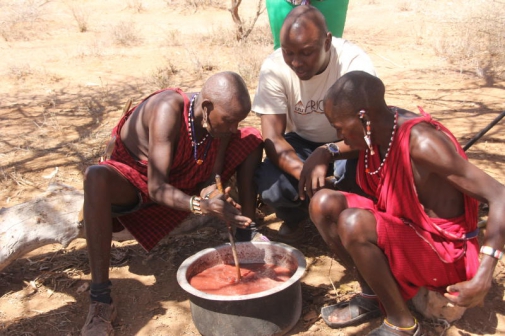
Scientists have confirmed more than 20 local plant species are effective against many of the top killer cancers today. During a three-day annual scientific conference of Kenya Medical Research Institute (Kemri), more than 30 researchers left no doubt that the country has immense capacity to deal with cancer from its plant resources. The scientists from various local universities collaborating with Kemri described how they hunted down, studied and confirmed in laboratories that plant extracts hold effective treatments to even the most deadly cancers.
The evidence presented at the KASH conference in Nairobi in February left no doubt that every Kenyan dying of cancer lives near or next to a possible cancer treatment or cure. Between the researchers, 16 projects were presented involving about 20 plants, some including pearl millet and the sijambok pod.
TREE’S BARK
Most of the plants the scientists reported are widely used locally for medicinal purposes and many specifically for treating cancer. “Over 60 per cent of currently used anti-cancer agents are derived from natural sources,” explained Sabina Wangui Wachira of Centre for Traditional Medicine and Drug Research at Kemri. “Our work was to provide scientific evidence to support claims that some Kenya medicinal plants are active against cancer.” Wachira, in the work also involving Jomo Kenyatta University of Agriculture and Technology, investigated the effectiveness of three local plants against cancers. These included the well-known red stinkwood (Prunus africana), which has been exploited internationally for the treatment of prostate cancer. However, this time around they were testing the effectiveness of the tree’s bark against breast cancer, a major killer of women in Kenya. “We found extracts from the bark highly effective against breast cancer cell lines, explaining why many communities use it as a medicine,” she told the conference.
She told of their drawback in trials with the local confetti and the pepper-wood trees, the latter known as Mkaa in Kiswahili. The two trees, the researchers reported had shown little activity against breast cancer but were very effective against the cell lines of colon cancer. Crispus M Ngule of the same department at Kemri told of their experiments with tamarind fruit (Mkwanju) and pearl millet. They tested extracts from these plants against prostate, cervical and breast cancers and found them to be highly effective. “Our findings are a scientific justification on the probable use of pearl millet and tamarind fruits in the treatment and management of cancer.” For the three days, such heart-warming stories were told more than a dozen times, explaining how different plant species and parts had passed crucial laboratory tests on their effectiveness in stopping the proliferation of cancerous cells. A combination of the highly popular and already domesticated Moringa oleifera or drumstick with leaf extracts of the African Indigo called Sargellat by the Marakwet of the Rift Valley had also been investigated
IMPRESSIVE ARSENAL
Researcher Jecinta Wanjiru Ndungu of Rongo University said the two trees were seen to stop the proliferation of cervical, breast and prostate cancer cell lines in the laboratory. Even when tested against the drug Tamoxifen, for breast cancer, the local herbs were found to stand their ground well. This was not the first time Kenyan researchers were presenting evidence that local plants have provable ability to treat cancer. But it was definitely the first time Kenya’s premier research institute had brought under one roof such an impressive arsenal against the deadly killer. “We are happy scientists are now confirming what we have always known and practised. It is then time to convert the knowledge into products and service,” said Dr Shadrack Moimett of Koibatek Herbal Clinic in Eldoret. Such an assurance though, was conspicuously lacking from the Kemri conference. With no exception, all presenters recommended further research in their work before any drugs can be developed. “Further studies are recommended to isolate the bioactive compounds from the crude extracts and determine their mechanisms of action against cancerous cells,” said Regina Mwangangi of Kenyatta University. Mwangangi had presented victories against breast cancer from the extracts of the much known black wattle tree and the bitter leaf vegetable plant called Lisabakhwa by the Luhya.
But this prescribed route to product development, Dr Moimett and other experts say, could be painfully long and prohibitively expensive, a cost that would be reflected in the final product. Julius Wanjohi Mwangi, lecturer and director of Intellectual Property Rights at University of Nairobi, estimates that it takes ten to 17 years and between $200 million (Sh20 billion) to over $2 billion (Sh200 billion) to develop a new conventional drug. Mwangi, a professor of Pharmacognosy (the study of medicine derived from natural sources), broke new ground two years ago when he presented the first public defence of herbal medicine at the University of Nairobi. Mwangi and a team from the university had collected data at a herbal medicine clinic in Nakuru for five years. During the period, about 55,000 people had been treated at the clinic. Some 6,000 of the patients had gone to the clinic with heart conditions while another 2,000 had cancer. In his presentation, Mwangi demonstrated that herbal medicines actually work against many diseases, including cancer. Mwangi, Moimett and other like-minded experts are suggesting that Kenya goes the Chinese way to quickly develop safe and affordable natural health products. “We could learn from the Chinese, who are doing a lot of clinical and other scientific work on their herbal medicines while concurrently using them in their hospitals,” said Mwangi. Luckily for thousands of Kenyans waiting for science-backed herbal cancer treatments., things are finally looking up.
The Health Bill 2016, now in its final stages in Parliament suggests the formation of a legal body to oversee the management of alternative medicine in Kenya. Such a body will set standards for all herbal products and, importantly, formulate policies to facilitate the referral of patients between herbalists and conventional hospitals. Further, the Government’s proposed Traditional Herbal Medicine and Medicinal Plants Bill 2014, if and when it becomes law. could be a game changer because it allows for Kenya to go the Chinese way with herbal medicines. But while experts, bureaucrats and politicians argue on which way to go, Kenyans suffering from cancer are hardly waiting. A recent study revealed that among 115 cancer children at Moi Teaching and Referral Hospital, Eldoret, 95 per cent had been given by their parents complementary medicines such as herbs. A 2011 World Bank survey estimated there are 40,000 herbalists in Kenya compared to about 4,500 doctors
-Source link-standardmedia.co.ke








